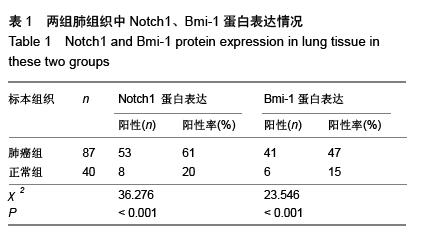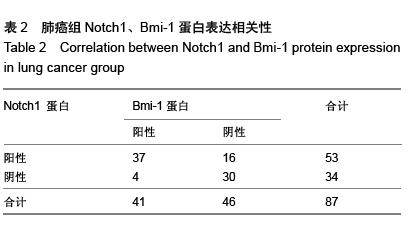| [1] 陈实,李德川,刘华.姜黄素诱导人肺癌细胞凋亡及其机制[J].武汉大学学报:医学版,2012,33(4):507-510,527.
[2] 李海燕,刘红,王静,等.瘤标志物联合检测在肺癌诊断中的价值[J].中国老年学杂志,2012,32(1):46-48.
[3] 马莉,高晓虹,王猛,等.肺癌影响因素病例对照研究[J].中国公共卫生,2012,28(1):90-91.
[4] 曾庆岳,陶红艳,万毅新,等.慢性阻塞性肺疾病与肺癌关系临床研究[J].中国现代医学杂志,2012,22(12):68-71.
[5] 李娜,王燕.23例肺癌并发肺栓塞的临床分析[J].中国肺癌杂志, 2014,17(3):254-259.
[6] Bridges E, Oon CE, Harris A. Notch regulation of tumor angiogenesis. Future Oncol. 2011;7(4):569-588.
[7] 王利祥,华子春. Notch信号通路研究进展[J].中国医药生物技术,2009,4(3):224-226.
[8] 何晓彬,赖敏.NF-κB、Notch-1和Ki-67在结肠癌中的表达及其意义[J].重庆医学,2012,41(3):230-232.
[9] Fan RH, Li J, Wu N, et al. Late SV40 factor: a key mediator of Notch signaling in human hepatocarcinogenesis. World J Gastroenterol. 2011;17(29):3420-3430.
[10] 王依满,杨晶金,权明明,等. HES1与ICN1、Notch1在胃癌组织中的表达及其意义[J]. 中国卫生检验杂志,2012,22(1):87-89.
[11] Herranz H, Milán M. Signalling molecules, growth regulators and cell cycle control in Drosophila. Cell Cycle. 2008;7(21): 3335-3337.
[12] Donnem T, Andersen S, Al-Shibli K, et al. Prognostic impact of Notch ligands and receptors in nonsmall cell lung cancer: coexpression of Notch-1 and vascular endothelial growth factor-A predicts poor survival. Cancer. 2010;116(24): 5676-5685.
[13] 张超,姚志勇,朱鸣阳,等. MicroRNA-34a通过Notch1对膀胱肿瘤细胞株T24增殖的影响[J].解放军医学杂志,2012,37(5): 426-430.
[14] 刘健,万磊,程园园,等.佐剂关节炎大鼠肺功能与Treg、Notch信号通路的关系[J].中国免疫学杂志,2012,28(9):825-830.
[15] 吴健,张昶,朱亚宁.Bmi-1蛋白在食管鳞状细胞癌中表达及临床意义[J].中国肿瘤临床,2012,39(13):911-913.
[16] 郑伟,吉巧红,李三强,等.Bmi-1、Notch1在乳腺癌中的表达及意义[J].河南科技大学学报:医学版,2014,32(1):7-9.
[17] 魏东,邹浩,王琳,等.靶向miRNA干扰Bmi-1诱导胆囊癌细胞凋亡及上调Caspase-3表达的研究[J].中国生物工程杂志,2013, 33(12):1-8.
[18] 谢爱民. Notch1及Bmi-1在肺癌干细胞中表达的相关性及临床意义[J].实用医学杂志,2014,30(7):1104-1107.
[19] 武向梅,余华荣,卜友泉,等. 沉默Bmi-1基因表达稳定细胞株的建立及其生物学特性的研究[J].生命科学研究,2012,16(2): 158-163.
[20] 徐珍珍,吴顺泉,战榕.Bmi-1 shRNA慢病毒表达载体的构建及稳转U266细胞株的建立[J].中国实验血液学杂志,2012, 20(2): 473-477.
[21] 胡花丽,冯爱强,张彦武,等. Bmi-1及Mel-18在乳腺癌中的表达及其与临床病理特征的关系[J].中国普通外科杂志, 2012, 21(11): 1410-1414.
[22] 廖雯婷,崔艳梅,丁彦青. Bmi-1PTEN及E-Cadherin在结直肠癌中的表达和意义[J].中国肿瘤临床,2012,39(9):559-563.
[23] 李白翎,金磊,钟铿,等.非小细胞肺癌组织Bmi-1和VEGF表达及其临床意义的研究[J].中华肿瘤防治杂志,2012,19(21): 1610-1613.
[24] 王伟,李勇,牛旗.从耐顺铂肺腺癌A549/DDP细胞系分离和鉴定肺癌干细胞的研究[J]. 中华临床医师杂志:电子版, 2012, 6(22):7229-7232.
[25] Pesch B, Casjens S, Stricker I,et al. NOTCH1, HIF1A and other cancer-related proteins in lung tissue from uranium miners--variation by occupational exposure and subtype of lung cancer. PLoS One. 2012;7(9):e45305.
[26] 曹慧秋,文继舫,胡玉林,等.肺鳞状细胞癌中Notch1-4和DLL4的表达及与微血管密度的相关性[J].临床与实验病理学杂志, 2012,28(8):842-847.
[27] 邵新宏,于游,张才全. miR-34a靶向调控NOTCH1基因对SW480细胞增殖的影响[J]. 第三军医大学学报, 2012,34(22): 2297-2301.
[28] 陈伟,曹罡,董震,等.人Notch4基因RNAi慢病毒载体的构建及鉴定[J]. 医学研究生学报,2013,26(2):116-121.
[29] 张同韩,刘海潮,梁玉洁,等. Notch信号通路分子在舌鳞癌中的表达及意义[J]. 华西口腔医学杂志,2013,31(3):303-309.
[30] Guo J, He L, Yuan P, et al. ADAM10 overexpression in human non-small cell lung cancer correlates with cell migration and invasion through the activation of the Notch1 signaling pathway. Oncol Rep. 2012;28(5):1709-1718.
[31] 张洪开,徐韬钧,具英花,等.PI3K和MAPK信号通路通过FOXO1转录因子诱导A549细胞周期的阻滞和凋亡的研究[J].中国医科大学学报,2012,41(10):908-911.
[32] 陈玲.结肠癌组织中Bmi-1表达变化及意义[J].现代诊断与治疗, 2014,25(16):3810-3812.
[33] 郑伟,吉巧红,李三强,等. Bmi-1、Notch1在乳腺癌中的表达及意义[J]. 河南科技大学学报:医学版, 2014,32(1):7-9.
[34] 邹艳芳,田永,徐峰. Bmi-1和Mel-18基因在大肠癌组织中的表达及意义[J]. 世界华人消化杂志,2013,21(5):397-402.
[35] 郑翔宇,朱杰,王艺芳,等. Bmi-1-siRNA对肺腺癌A549细胞体内外增殖能力的影响[J]. 中国癌症杂志,2013,23(7):505-511.
[36] 李海玉,武向梅,陈兴凤,等.siRNA介导的Bmi-1基因沉默对乳腺癌细胞株MDA-MB-231侵袭迁移的影响[J].中国免疫学杂志,2014,30(4):475-479.
[37] 徐磊,蒋峰,杨欣,等. miR-203下调Bmi-1基因对肺腺癌细胞侵袭转移的影响[J]. 临床肿瘤学杂志,2014,19(4):289-293.
[38] Zhu LB, Xu Q, Hong CY,et al. XPC gene intron 11 C/A polymorphism is a predictive biomarker for the sensitivity to NP chemotherapy in patients with non-small cell lung cancer. Anticancer Drugs. 2010;21(7):669-673.
[39] 毛楠,何关生,饶进军,等.沉默Bmi-1表达可逆转肺癌细胞对顺铂的耐药性[J].南方医科大学学报,2014,34(7):1000-1004.
[40] 唐甜,陕光. Bmi-1和EZH2基因在小细胞肺癌中的表达及其意义[J]. 中国组织化学与细胞化学杂志,2012,21(1):48-52.
[41] 刘丹丹,姜悦,刘奔,等. Bmi-1 siRNA对宫颈癌Hela细胞体外增殖能力的影响[J]. 大连医科大学学报,2012,34(2):109-114. |
.jpg)



.jpg)
.jpg)